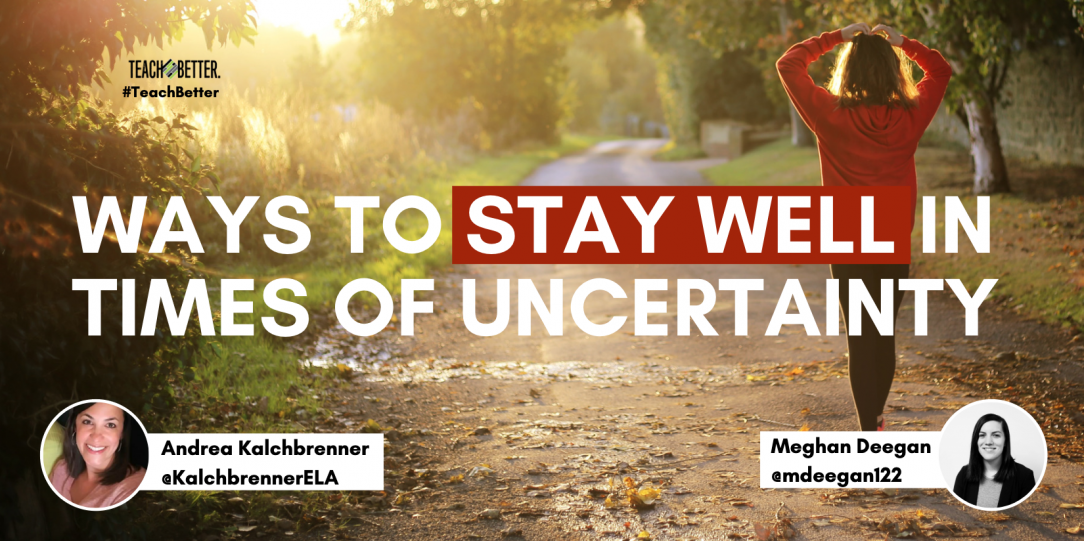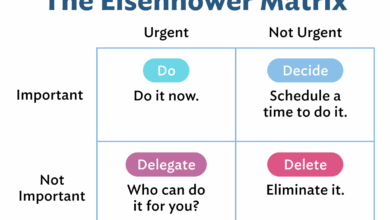
6 ways to stay calm while dealing with uncertainty. Navigating a world filled with unknowns can be daunting, but it doesn’t have to be overwhelming. This exploration dives into practical strategies to manage the anxieties that uncertainty brings, helping you stay grounded and centered amidst the chaos. From understanding the nature of uncertainty to developing a growth mindset, we’ll uncover powerful tools to empower you through any situation.
This guide explores six key strategies for maintaining composure when faced with uncertainty. We’ll examine the multifaceted nature of uncertainty, delve into mindfulness techniques, and equip you with problem-solving skills. We’ll also touch on the importance of support systems, self-care, and cultivating a growth mindset to weather life’s inevitable storms.
Understanding Uncertainty
Uncertainty, a pervasive aspect of human experience, is not simply the lack of knowledge but a multifaceted concept encompassing the possibility of various outcomes, both positive and negative. It’s the feeling of being unsure about the future, the present, or even the past, and it can stem from personal choices, professional pressures, or even societal shifts. This feeling is often accompanied by a range of physiological and psychological reactions, making it crucial to understand how uncertainty impacts our lives.
Defining Uncertainty
Uncertainty is the state of being unsure or not knowing something. It’s not simply a lack of information, but a recognition that multiple possibilities exist, and their probabilities are not clearly defined. This inherent ambiguity can stem from incomplete data, complex systems, or simply the inherent unpredictability of life. It encompasses a wide range of scenarios, from personal doubts about the future to the global uncertainties affecting the economy and society.
Types of Uncertainty
Uncertainty manifests in various forms, affecting different aspects of our lives. Personal uncertainty can involve choices about career paths, relationships, or personal growth. Professional uncertainty might stem from economic downturns, industry changes, or unexpected job losses. Societal uncertainty can involve political shifts, environmental crises, or global pandemics. These uncertainties often intertwine, creating a complex web of challenges.
Physiological and Psychological Responses
Uncertainty can trigger a cascade of physiological and psychological responses. Physiological reactions might include increased heart rate, elevated blood pressure, and muscle tension. Psychologically, uncertainty can lead to feelings of anxiety, stress, fear, or even depression. These responses are often adaptive, prompting us to prepare for potential challenges, but prolonged exposure to uncertainty can negatively impact mental and physical well-being.
Demographic Variations in Reactions to Uncertainty
The impact of uncertainty varies significantly across demographics, influencing how individuals cope and respond.
| Demographic | Common Reactions | Potential Explanations |
|---|---|---|
| Age (Young Adults) | Increased anxiety, fear of the future, difficulty planning long-term | Greater exposure to career choices, relationship pressures, and economic uncertainty. |
| Age (Middle-Aged Adults) | Increased stress, concern for family, financial security | Responsibilities for family and financial burdens, mid-life career transitions. |
| Age (Seniors) | Uncertainty about health, retirement, and legacy | Concerns related to health, financial stability in retirement, and the future of their family. |
| Gender | Women may experience higher levels of anxiety related to societal expectations and caregiving responsibilities. Men may experience more stress related to career pressures and economic uncertainty. | Social roles and expectations, and varying experiences of the workforce. |
| Cultural Background | Uncertainty may be perceived and processed differently based on cultural values and beliefs. | Varying cultural approaches to risk-taking, decision-making, and community support systems. |
Impact on Daily Life
Uncertainty permeates daily life, impacting decisions from what to eat for breakfast to choosing a career path. Consider the impact of economic uncertainty on purchasing decisions or the anxiety associated with unexpected events like a natural disaster. Even seemingly small uncertainties, like whether the bus will be on time, can create stress and disrupt routines. The continuous presence of uncertainty requires proactive strategies for managing its effects.
Cultivating Mindfulness
Uncertainty often triggers a cascade of anxious thoughts and feelings. One powerful tool for navigating these turbulent waters is cultivating mindfulness. Mindfulness, at its core, is the practice of paying attention to the present moment without judgment. This focused awareness can significantly reduce the grip of uncertainty by fostering a sense of calm and control over our internal landscape.
By understanding and integrating mindfulness techniques into our daily lives, we can equip ourselves with a powerful coping mechanism for managing the inevitable anxieties associated with the unknown.Mindfulness techniques, such as meditation and deep breathing, provide concrete pathways to managing the mental chatter and emotional turbulence that uncertainty can induce. These techniques are not about eliminating thoughts or emotions, but rather about observing them without getting swept away by them.
This detached observation allows us to respond to uncertainty with a greater sense of clarity and composure.
Mindfulness Techniques for Uncertainty
Mindfulness techniques offer a diverse range of approaches to cultivate present moment awareness. These techniques can be used individually or in combination to create a personalized strategy for managing uncertainty. Practicing these techniques regularly can build resilience and equip individuals with tools to navigate challenging situations with greater composure.
- Meditation: Meditation, in its various forms, is a cornerstone of mindfulness practice. Different types of meditation, such as focused attention meditation, open monitoring meditation, and loving-kindness meditation, each offer unique benefits. Focused attention meditation, for example, involves focusing on a specific object, such as the breath or a mantra, to cultivate concentration. This focused attention helps quiet the mind’s incessant chatter, fostering a sense of calm and presence.
Open monitoring meditation, on the other hand, involves observing thoughts and feelings without judgment, creating space to observe the nature of uncertainty without getting entangled in it. Loving-kindness meditation cultivates compassion and empathy, helping to soothe the emotional turbulence that uncertainty can create.
- Deep Breathing Exercises: Deep breathing exercises are readily accessible and incredibly effective tools for calming the nervous system. These techniques involve slow, deliberate breaths, focusing on the inhalation and exhalation. Deep breathing activates the parasympathetic nervous system, counteracting the stress response and promoting relaxation. By focusing on the physical sensation of the breath, we can anchor ourselves in the present moment, reducing the tendency to get carried away by anxieties related to uncertainty.
- Body Scan Meditation: A body scan meditation involves systematically bringing awareness to different parts of the body. By paying attention to sensations, whether they are physical discomfort, tension, or simply a feeling of numbness, individuals can develop a deeper connection with their physical selves. This awareness helps to reduce physical tension associated with stress and anxiety stemming from uncertainty. By focusing on physical sensations, individuals can create a grounded connection to the present moment, reducing the tendency to get lost in worries about the future.
Step-by-Step Guide to Practicing Mindfulness
Integrating mindfulness into daily life is a gradual process. The following steps can guide you in incorporating mindfulness into your routine. Consistent practice, even in short durations, can yield significant benefits in managing uncertainty.
- Find a quiet space: Choose a location free from distractions, where you can comfortably sit or lie down.
- Establish a regular time: Schedule specific times for your mindfulness practice, much like any other important appointment.
- Focus on your breath: Pay attention to the sensation of your breath entering and leaving your body. Notice the rise and fall of your chest or abdomen. Observe the feeling of air moving through your nostrils.
- Acknowledge thoughts and feelings: As thoughts and feelings arise, acknowledge their presence without judgment. Simply observe them as they come and go, without getting caught up in them.
- Return to your breath: When your mind wanders, gently redirect your attention back to your breath. This process of returning is a core element of mindfulness practice.
Mindfulness Exercises and Their Benefits
| Mindfulness Exercise | Benefits for Reducing Anxiety in the Face of Uncertainty |
|---|---|
| Focused Attention Meditation | Reduces mental chatter, promotes concentration, fosters calm |
| Open Monitoring Meditation | Cultivates non-judgmental observation of thoughts and feelings, reduces entanglement in uncertainty |
| Deep Breathing Exercises | Activates the parasympathetic nervous system, reduces stress response, promotes relaxation |
| Body Scan Meditation | Reduces physical tension, promotes body awareness, fosters a grounded connection to the present moment |
| Mindful Walking | Integrates mindfulness into daily activities, reduces anxiety, enhances present moment awareness |
Present Moment Awareness
Present moment awareness is crucial for coping with uncertain situations. By focusing on the here and now, individuals can reduce the tendency to dwell on anxieties about the future or regrets about the past. This focus on the present moment allows individuals to approach challenges with greater clarity and composure, rather than being overwhelmed by the unknown. The present moment offers a space for stability and groundedness in the face of uncertainty.
Building Resilience: 6 Ways To Stay Calm While Dealing With Uncertainty

Navigating uncertainty often feels overwhelming. However, developing resilience is a powerful tool for weathering the storms of life’s unpredictable moments. Resilience isn’t about avoiding challenges, but rather about bouncing back from them stronger and more adaptable. This process involves understanding your strengths, fostering positive coping mechanisms, and cultivating a growth mindset. Let’s explore how you can build resilience in the face of uncertainty.Resilience is the ability to adapt and recover from adversity, trauma, tragedy, threats, or significant sources of stress.
It’s not about eliminating stress, but about developing the inner strength to cope effectively with it. Resilient individuals often possess a unique combination of traits and strategies that allow them to thrive amidst challenges.
Key Traits of Resilient Individuals
Resilient individuals exhibit several key traits. They typically demonstrate a proactive approach to problem-solving, maintaining a positive outlook, and demonstrating emotional regulation. They often have strong social support networks, providing a sense of belonging and encouragement. Furthermore, they typically have a sense of self-efficacy, believing in their ability to overcome obstacles. This self-belief is often tied to a growth mindset.
Strategies for Developing Resilience
Developing resilience is an ongoing process, requiring consistent effort and practice. Proactive coping mechanisms are crucial. These involve identifying potential stressors, developing strategies to manage them, and building a support system. Taking care of your physical health through regular exercise, proper nutrition, and sufficient sleep is also critical for resilience. A balanced lifestyle contributes significantly to emotional well-being and reduces vulnerability to stress.
The Role of Positive Self-Talk
Positive self-talk plays a pivotal role in building resilience. It involves challenging negative thoughts and replacing them with positive affirmations. For instance, instead of focusing on “I can’t do this,” you might reframe your thoughts to “I’m capable of overcoming this challenge.” Regularly practicing positive self-talk can significantly improve self-esteem and increase confidence in your ability to handle uncertainty.
Cultivating a Growth Mindset in Response to Uncertainty, 6 ways to stay calm while dealing with uncertainty
Uncertainty often triggers fear of failure. However, adopting a growth mindset fosters a belief that abilities and intelligence can be developed through dedication and hard work. This contrasts with a fixed mindset, which assumes that abilities are static. Embracing a growth mindset enables you to view setbacks as opportunities for learning and improvement, thereby enhancing resilience.
Actionable Steps for Building Resilience
- Identify Your Stressors: Recognizing situations or events that trigger stress allows for proactive management. Create a list of your stressors, noting how they make you feel.
- Develop Coping Mechanisms: Develop healthy strategies for managing stress, such as mindfulness exercises, deep breathing, or engaging in hobbies.
- Build a Support System: Nurturing relationships with friends, family, or mentors provides a safety net during challenging times.
- Practice Self-Care: Prioritize physical health by maintaining a balanced diet, getting adequate sleep, and engaging in regular exercise.
- Embrace a Growth Mindset: View setbacks as opportunities for learning and growth, not as failures.
- Challenge Negative Thoughts: Identify and challenge negative self-talk, replacing it with positive affirmations.
- Celebrate Small Victories: Acknowledge and appreciate your progress, no matter how small, to maintain motivation.
Effective Problem-Solving Strategies

Uncertainty often presents complex problems that require careful consideration and structured approaches. Effective problem-solving strategies can significantly reduce the feeling of being overwhelmed and allow for more rational decision-making in the face of ambiguity. These strategies provide a framework for navigating the unknown and developing solutions that are tailored to the specific situation.
Problem-Solving Approaches
Different approaches to problem-solving can be employed, depending on the nature of the issue and the available information. Brainstorming, for instance, encourages the generation of numerous ideas, even if seemingly unconventional or outlandish at first. SWOT analysis, a more structured method, identifies Strengths, Weaknesses, Opportunities, and Threats related to the problem, providing a comprehensive view of the situation.
These and other methods can be used individually or in combination to develop a robust and adaptable approach.
Figuring out how to stay calm amidst uncertainty can be tricky, but thankfully there are some helpful strategies. One thing that can definitely throw off your zen is the thought of all the bacteria lurking on your kitchen towels, which you should probably wash more often, especially since your kitchen towels are probably full of bacteria. Ultimately, focusing on practical steps, like creating a plan and practicing mindfulness, is key to navigating those uncertain times.
Breaking Down Complex Problems
Complex problems often feel insurmountable, but breaking them down into smaller, manageable parts is crucial. This process, akin to dividing a large task into smaller steps, allows for a more focused and less intimidating approach. By addressing each component individually, the overall problem becomes more approachable and less daunting. For example, if a company is facing declining sales, breaking this down into sub-problems like market research, product improvement, and marketing strategy allows for a more targeted and effective response.
Identifying and Evaluating Potential Solutions
Once the problem is broken down, the next step involves generating and evaluating potential solutions. This process involves considering various options and assessing their feasibility and potential impact. A crucial aspect is assessing the potential risks and benefits associated with each solution. For example, when a team is facing delays in a project, potential solutions could include assigning additional resources, streamlining workflows, or seeking external expertise.
Evaluating these options based on cost, time, and effectiveness is essential.
Examples in Uncertain Scenarios
Consider a startup facing uncertain market demand. Using brainstorming, the team might generate ideas for a flexible product offering, or focusing on a niche market. A SWOT analysis would help identify the company’s strengths (e.g., innovative technology) and weaknesses (e.g., limited marketing budget), as well as potential opportunities and threats. By breaking down the problem into specific areas (market research, product development, marketing), the startup can approach each segment with focused solutions.
Comparison of Problem-Solving Methods
| Method | Description | Effectiveness in Uncertain Situations | Example |
|---|---|---|---|
| Brainstorming | Generating numerous ideas, even unconventional ones. | High, as it encourages creativity and diverse perspectives. | A team brainstorming ways to improve customer satisfaction in a fluctuating market. |
| SWOT Analysis | Identifying Strengths, Weaknesses, Opportunities, and Threats. | High, as it provides a structured framework for understanding the situation. | A company analyzing its position in a new market with emerging competitors. |
| Root Cause Analysis | Identifying the underlying causes of a problem. | High, as it goes beyond symptoms to address the core issue. | Investigating the reasons behind declining sales of a particular product. |
| Decision Matrix | Evaluating options based on weighted criteria. | Medium, providing a structured approach for complex decisions. | Choosing the best marketing strategy for a product with limited resources. |
Seeking Support and Connection
Navigating uncertainty can feel isolating. It’s easy to feel overwhelmed and alone when facing unknown challenges. However, connecting with others can provide crucial support and perspective. Strong social connections can help us process emotions, gain different viewpoints, and find strength in shared experiences. This crucial aspect of managing uncertainty is often overlooked, but its importance cannot be overstated.Social support networks offer a buffer against the negative impacts of uncertainty.
Sharing experiences, offering encouragement, and receiving advice from trusted individuals can significantly reduce stress and improve our ability to cope with the unknown. Moreover, feeling understood and validated by others can help us maintain a sense of control and hope during challenging times.
Importance of Social Support Networks
Social support networks are vital for managing uncertainty. They provide a sense of belonging and validation, helping individuals feel less alone and more resilient in the face of adversity. These networks can offer practical assistance, emotional comfort, and a sense of shared experience. Strong social connections act as a safety net, providing a foundation for navigating uncertain situations and fostering a sense of hope.
Connecting with Others Facing Similar Challenges
Finding others facing similar challenges is invaluable. Online forums, support groups, and local community organizations can connect individuals with people who understand their experiences. Sharing stories, strategies, and coping mechanisms can be incredibly helpful in feeling less isolated. Moreover, observing how others are handling similar uncertainty can offer new perspectives and insights.
Effective Communication Strategies for Uncertainty
Communicating effectively about uncertainty is crucial. Clear and honest communication about feelings and needs is essential. Actively listening to others and validating their experiences is equally important. Expressing concerns openly and honestly can foster trust and understanding within relationships.
Identifying Potential Support Systems
Numerous support systems can help during times of uncertainty. Family members, close friends, mentors, and support groups can all play a vital role. Identifying and leveraging these resources can make a significant difference in managing uncertainty effectively. Seeking guidance from mentors who have navigated similar situations can provide valuable insights.
Support System Table
| Support System | Benefits |
|---|---|
| Family | Provides a sense of belonging, emotional support, and practical assistance. Often readily available and familiar. |
| Friends | Offer emotional support, understanding, and companionship. Can provide a sounding board and different perspectives. |
| Mentors | Offer guidance, experience, and advice based on their journey through similar challenges. Provide a trusted source of knowledge and wisdom. |
| Support Groups | Provide a sense of community and shared experience. Allow individuals to connect with others facing similar situations and learn from their experiences. Support groups offer a safe space for sharing, and learning from others. |
Developing a Growth Mindset
Navigating uncertainty often feels like a rollercoaster of emotions. Fear, anxiety, and doubt can take hold, making it challenging to adapt and persevere. However, cultivating a growth mindset can significantly buffer these negative feelings and empower you to face uncertainty with resilience. A growth mindset isn’t about denying challenges or pretending everything is perfect; instead, it’s about embracing them as opportunities for learning and growth.A growth mindset fundamentally shifts our perspective on our abilities and potential.
Instead of viewing intelligence and talents as fixed traits, a growth mindset recognizes them as malleable qualities that can be developed through dedication and effort. This understanding is crucial when facing uncertainty, as it allows us to view setbacks not as failures, but as stepping stones toward improvement. This flexible approach is paramount for successfully navigating life’s unpredictable nature.
The Relationship Between Growth Mindset and Uncertainty
Uncertainty often triggers feelings of helplessness and inadequacy. A growth mindset counters these feelings by emphasizing the potential for improvement. By embracing the idea that our abilities can be developed, we become more open to learning from mistakes and adapting to changing circumstances. This adaptability is essential for navigating uncertainty effectively.
Fostering Adaptability and Flexibility
A growth mindset fosters adaptability and flexibility by encouraging a proactive approach to learning and problem-solving. Individuals with a growth mindset are more likely to seek out new challenges, embrace different perspectives, and view setbacks as opportunities for learning. This proactive approach allows for quicker adjustments to changing situations and facilitates smoother transitions through uncertain times. For example, if a project takes an unexpected turn, someone with a growth mindset is more likely to see this as an opportunity to learn new skills and refine their approach, rather than becoming discouraged or overwhelmed.
The Importance of Learning from Setbacks and Mistakes
Setbacks and mistakes are inevitable parts of life, especially when dealing with uncertainty. A growth mindset views these experiences not as failures, but as valuable learning opportunities. By analyzing what went wrong, identifying areas for improvement, and adjusting strategies accordingly, we can build resilience and navigate future uncertainties more effectively. This approach emphasizes the cyclical nature of learning, where mistakes are not terminal but rather integral to the process of development.
Figuring out 6 ways to stay calm amidst uncertainty can be tricky, especially when facing a health challenge like melanoma. Learning how immunotherapy works in treating melanoma can be a really helpful piece of the puzzle in feeling more in control. How does immunotherapy work melanoma is a great resource for understanding the process. Ultimately, staying grounded and informed through resources like this is key to managing uncertainty and anxiety.
Strategies for Reframing Negative Thoughts and Experiences
Reframing negative thoughts and experiences is a critical component of a growth mindset. When faced with uncertainty, negative self-talk can easily spiral out of control. Developing strategies to reframe these thoughts is essential for maintaining a positive and proactive attitude. For example, instead of thinking “I’m not good enough,” we can reframe this thought as “I can learn and improve my skills.” This shift in perspective fosters a more optimistic and productive approach to uncertainty.
Figuring out how to stay calm during uncertain times can be tough, but there are definitely some helpful strategies. For example, focusing on what you can control, like getting enough sleep, is crucial. This is especially important when considering how menopause and sleep quality can impact migraine symptoms, as detailed in this insightful article about how menopause and sleep quality can impact migraine symptoms.
Ultimately, practicing mindfulness and self-care techniques, along with these other 6 calming strategies, can help you navigate the unknown with a bit more ease.
Cultivating a Growth Mindset: Strategies
Adopting a growth mindset is an ongoing process, not a destination. Consistent effort and a willingness to learn are crucial. Here are some strategies to cultivate a growth mindset:
- Embrace challenges: Stepping outside your comfort zone and tackling new situations can help you develop new skills and build resilience. Examples include taking on a new hobby, trying a new sport, or volunteering for a challenging project at work.
- Focus on effort and learning: Recognize that progress comes from consistent effort and a willingness to learn. Focusing on the process rather than the outcome can help you stay motivated and engaged even when facing setbacks.
- Seek feedback: Actively solicit feedback from others to identify areas for improvement and gain different perspectives on your work and actions. Constructive criticism can be incredibly valuable.
- Learn from mistakes: View mistakes as opportunities to learn and grow. Analyze what went wrong, identify areas for improvement, and adjust your strategies accordingly.
- Maintain a positive attitude: Cultivate a positive outlook and resilience by focusing on your strengths and celebrating your progress. This can be achieved through journaling, affirmations, or positive self-talk.
- Surround yourself with positive influences: Spend time with people who support your growth and encourage a growth mindset. Their positive energy can inspire you to learn and strive for improvement.
Prioritizing Self-Care
Navigating uncertainty can be incredibly stressful. It’s easy to get caught up in worrying about the future or analyzing potential problems. However, one crucial aspect of managing stress in uncertain times is prioritizing self-care. Self-care isn’t a luxury; it’s a necessity for maintaining emotional well-being and building resilience. Taking care of our physical and mental health allows us to better cope with challenges and fosters a more positive outlook.Self-care encompasses a wide range of activities that nourish our bodies, minds, and spirits.
It’s not about perfection; it’s about consistency and finding practices that work for you. By incorporating self-care into our daily routines, we create a buffer against stress and equip ourselves with the tools to navigate challenging situations with greater ease and emotional stability.
Importance of Self-Care in Managing Stress
Self-care is fundamentally important for managing stress related to uncertainty. When we’re constantly bombarded with uncertainty, our stress levels tend to rise. By engaging in self-care activities, we create opportunities to de-stress and recharge. This, in turn, helps us to better process information, make decisions, and maintain a positive outlook. Stress management techniques, often incorporated in self-care routines, provide a pathway to navigate the anxieties associated with uncertainty.
Examples of Self-Care Activities
Prioritizing self-care involves consciously engaging in activities that promote well-being. These activities can range from simple to complex, depending on individual preferences and needs. Here are some examples:
- Exercise: Physical activity releases endorphins, which have mood-boosting effects. Regular exercise can help reduce stress and improve sleep quality, both of which are crucial for managing uncertainty.
- Healthy Eating: Nourishing our bodies with healthy foods provides the energy and nutrients needed to cope with stress. A balanced diet can improve our mood and overall well-being.
- Hobbies: Engaging in hobbies allows us to disconnect from stressful thoughts and worries. Creative pursuits, like painting, writing, or playing music, can be incredibly therapeutic.
- Mindfulness Practices: Activities like meditation or deep breathing exercises can help to calm the mind and reduce anxiety. These practices enhance self-awareness and emotional regulation.
- Adequate Sleep: Getting sufficient sleep is vital for emotional regulation and stress management. A well-rested mind is better equipped to handle uncertainty.
Link Between Self-Care and Emotional Well-being
Self-care is intrinsically linked to emotional well-being. When we prioritize self-care, we cultivate a sense of calm and stability. This emotional well-being provides a solid foundation for navigating uncertain times. Self-care acts as a preventative measure against emotional overwhelm. A strong emotional foundation provides a robust support system for coping with unpredictable situations.
How Self-Care Enhances Resilience and Coping Mechanisms
Self-care is a cornerstone of building resilience. By nurturing our physical and mental well-being, we develop the ability to bounce back from setbacks and challenges. Self-care enhances our coping mechanisms by providing the necessary resources to manage stress effectively. Regular self-care fosters a proactive approach to managing uncertainty, leading to increased resilience and adaptability.
Table of Self-Care Practices and Benefits
| Self-Care Practice | Benefits for Reducing Stress in Uncertain Situations |
|---|---|
| Exercise | Reduces stress hormones, improves mood, boosts energy levels |
| Healthy Eating | Provides essential nutrients, supports physical and mental well-being |
| Hobbies | Offers a distraction from worries, promotes creativity and relaxation |
| Mindfulness Practices | Reduces anxiety, improves focus, enhances emotional regulation |
| Adequate Sleep | Improves mood, reduces irritability, enhances cognitive function |
Summary
In conclusion, navigating uncertainty effectively involves a multifaceted approach. By understanding the different types of uncertainty, cultivating mindfulness, building resilience, and employing effective problem-solving strategies, you can develop a toolkit to manage the challenges ahead. Seeking support, fostering a growth mindset, and prioritizing self-care will further strengthen your ability to remain calm and composed in the face of the unknown.
Remember, you have the resources within you to handle any challenge.





